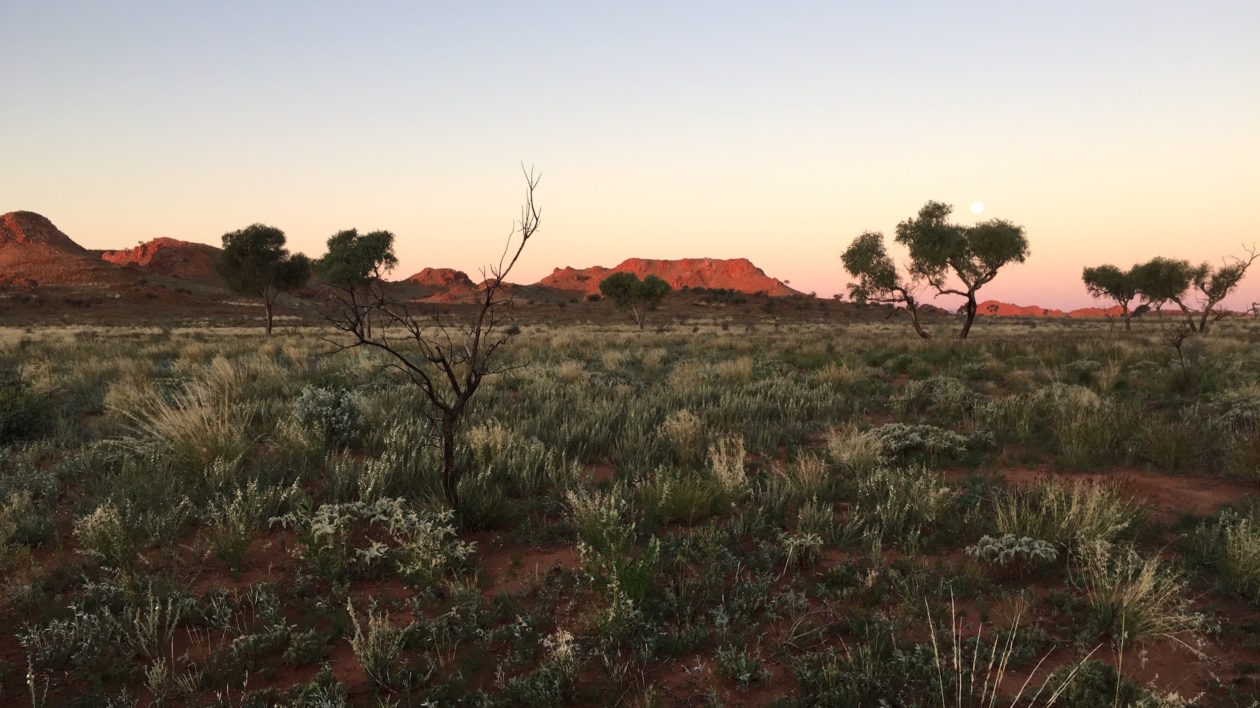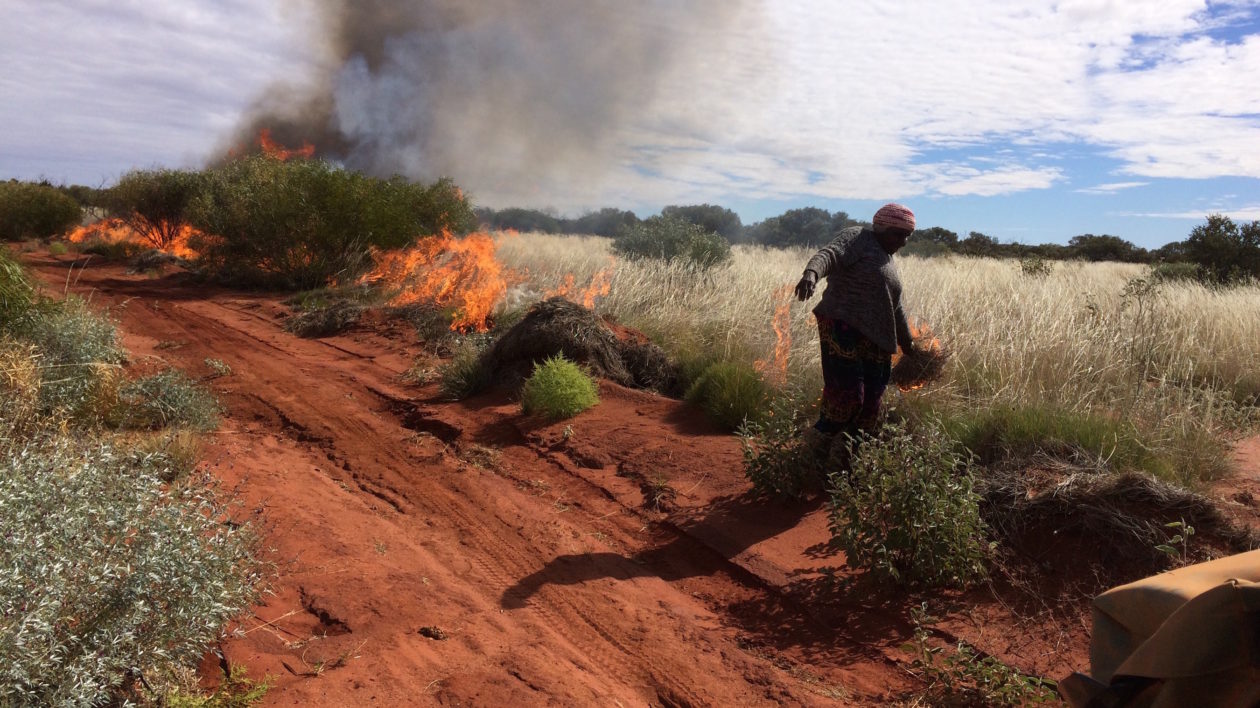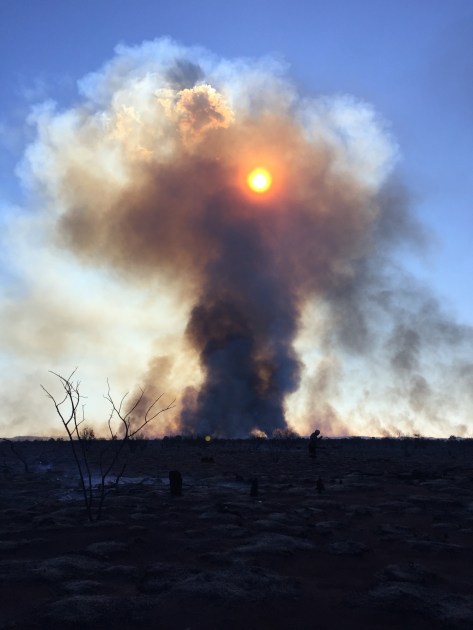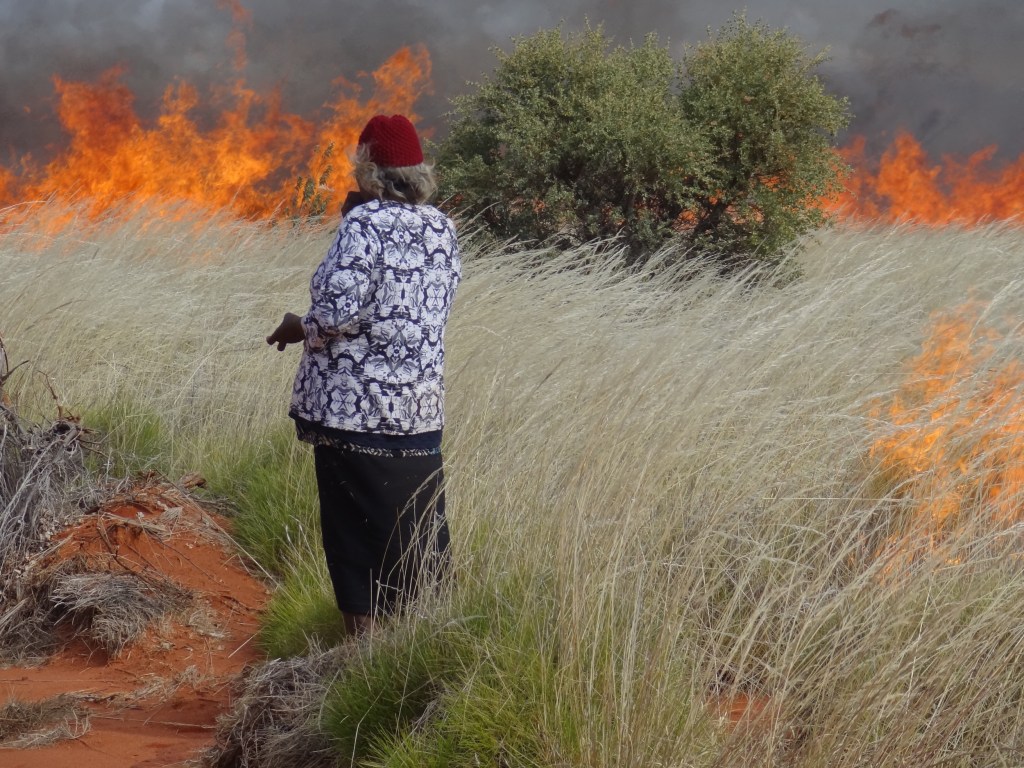Aboriginal and Torres Strait Islander viewers should use caution viewing this post, as it may contain mentions of deceased persons.
The air smells of smoke. One by one the Martu women toss matches into the spinifex, their iron digging sticks held in in one hand as they walk barefoot through the desert. Within minutes the grass is reduced to charred mounds, and the red sand in between them is littered with the tail and paw tracks of lizards and small mammals.
They stop at a charred acacia, where a goanna burrow is just visible beneath the shrub’s base. They’ve found their quarry, and today’s meal.
Hunting and fire — wartilpa and waru — are inextricably linked for the Martu people, the traditional owners of part of Australia’s Western Desert. Now, anthropological research shows that Martu burning — performed during hunting for sand goanna — actually increases biodiversity and benefits the desert ecosystem.
Painting the Desert with Fire
Australia’s Western desert is some of the most remote country in the world, but for the Martu people it’s home. About ~1,500 Martu live in four desert communities in Western Australia, and despite the availability of store-bought commodities they still live a semi-subsistence existence.
According to research by Doug Bird, an anthropologist specializing in human-environment dynamics at Penn State University, an estimated 25 to 50 percent of the average Martu diet consists of bush foods, including fruits, roots and tubers, seeds, sand goanna and other varanid lizards, python, skink, feral cat, kangaroo, emu, and bustard.
Men typically hunt the high-risk high-reward large game, like kangaroo and bustard, while the women gather fruits and seeds and hunt for goanna with steel digging sticks, or wana. In winter, the Martu burn as they hunt to clear away the spinifex grass, making it easier to locate goanna burrows and tracks in the rust-colored sands.
The Martu divide the process of post-fire regrowth into five separate stages: nyurnma, when the ground is bare; waru-waru from 6 months to 1 year of early regrowth; and nyukura, or mid-level regrowth from 1 to 5 years. Manguu extends from 5 to 15 years after a fire, when the spinifex grass is mature enough that a fire can carry, followed by kunarka, when old spinifex with decaying centers dominates.
Together, nyurnma, waru-waru, nyukura, mangu, and kunarka make up what scientists refer to as a patch mosaic — multiple different habitat types within an area small enough for a single species to utilize all of them. And it’s exactly this habitat type — created by hunting — that is critical to keeping country and its wildlife healthy.
Parnajarlpa, Kirti-kirti, & Waru
The idea that hunting increases biodiversity is paradoxical, but Bird’s research has shown direct benefits of hunting-related burning to desert fauna, particularly the monitor lizards, which are the target species for most hunting burns. Bird and his colleagues studied effects of patch-mosaic burning on the sand goanna (Varanus gouldii), a keystone species and predator in the spinifex desert and important prey item for the Martu.
Bird explains that sand goannas, which the Martu call parnajarlpa, love the edges or transition points between different habitats — they place their dens in older-growth vegetation and hunt in the recently-burned areas where there are different stages of vegetation regrowth.
This variety of habitat patches in different stages of post-fire successional growth is exactly the type of habitat that the Martu create when they set fire to the spinifex. “So by hunting goannas you actually increase their population densities,” says Bird. The ecological benefits from small-scale burning are great enough to offset the additional hunting pressure.

The benefits of burning extend beyond varanid lizards. Bird and his colleagues also studied the effect of burning on populations of hill kangaroo, also known as the common wallaroo or kirti-kirti. Hill kangaroos are another prey species for the Martu, but unlike the goannas they’re primarily hunted by men with shotguns.
First, Bird quantified hunting pressure on different areas of country as a measure of the number of foraging days per unit area. He then compared that data to surveys of hill kangaroo scat densities across the country.
Bird explains that, traditionally, kangaroo species are thought to be grazers — the Australian equivalent of the Serengeti’s herds of browsing wildebeest and gazelle. But the Martu had always insisted that the hill kangaroo weren’t only grass grazers, but browsed on other vegetation like fruit and acacia pods.
Not surprisingly, the Martu were right. Bird and his colleagues found that hill kangaroo populations are very similar in locations where Martu never hunt and in locations where they burn and hunt heavily. But in the intermediate zone — those places affected by Martu burning but with less direct hunting pressure — they found that kangaroo populations increase dramatically.
Bird realized that the fruit and acacia pods that the kangaroos prefer are found in areas recovering from human-set fires. “These dense patches of mid-successional vegetation where you get mature fruit are far more accessible in a Martu fire regime than in a lightning driven regime,” says Bird.
Hill kangaroos don’t roam far and wide in search of food; they stick to their natal range and when higher-quality food is consumed they move on to the lower-quality grasses. So scientists incorrectly assumed that kangaroos were grazers only. But in a country cared for by Martu, hill kangaroo thrive with access to more varied resources.

Without Fire, the World Will End
This interdependence between the Martu and their country is a form of co-evolution. Archaeological data suggest that Aboriginal peoples have resided in Australia for at least 50,000 years, and the flora and fauna of the country have evolved to require human presence on the landscape.
And when the Martu are not there to care for country, the system starts to unravel. The Martu were some of the final Indigenous Australians to make contact with westerners, many as late as the 1960s, and as a result of government-run mission programs they were largely removed from their country for 30 years. This absence eerily tracks the utter collapse of mammalian fauna across arid Australia.
In the last 200 years, Australia has a higher record of extinction of mammal species than anywhere else in the world. Fifty percent of the mammal species to go extinct during this time period are from Australia. More than 10 percent of Australia’s 273 endemic terrestrial mammals have gone extinct — a full 30 species — and a further 21 percent are currently threatened. For comparison, only one native land mammal, the sea mink, went extinct in continental North America following European settlement.

Without regular Martu burning to reduce fuel loads, lightning-caused fires burned much larger sections of country. These large wildfires don’t create the same patch-mosaic vegetation structure as Martu burning, and the result in changes to the ecosystem were an added challenge for native fauna already stressed by invasive predators.
And much of this species loss has occurred in the aridlands, far away from major human settlements. Of the 85 mammal species known from the arid zone 200 years ago, 11 are extinct, six are extinct on the mainland, and 16 are in decline. On Martu country, several species of native marsupial became locally extinct, including the rufous hare-wallaby (mala), brush-tail possum (wayuta), burrowing bettong (jamparn) and the golden bandicoot (minkajurru).
“The species that the Martu hunt rely on hunting, which is counterintuitive,” says Bird. He explains that the Martu blame themselves for the extinction of endemic fauna. “They say that we stopped hunting them as is specified in law, and when we stop hunting them the world collapses … those plants and animals that depend on their actions will cease to exist.”
Aboriginal burning — also known as fire-stick farming — is often characterized as land management. But that description doesn’t jibe with how the Martu approach their country. Healthy country is a byproduct of Martu cultural law, or jurkurrpa, which dictates a set of formal relationships, rights, and duties that the Martu have associated with their land estate.
“It’s not a designed land management strategy,” says Bird, “and it’s definitely not a conservation strategy.”
Hunting, burning, and holding country — wartilpa, waru, and kanyirninpa ngurrara — is done not because the Martu are managing their country, but because they are their country.
To learn more about Martu burning, watch the full-length film here.




Good write up of excellent research in Marty country. Expanding on the differences between men and women’s hunting patterns, you might note as the original research does, that womens hunting supports biodiversity outcomes in ways that men’s does not. This highlights the importance of gender equity in Aboriginal land management, but most policy and programs that support these activities are gender blind. For analysis of this from Warlpiri management in Northern Tanami IPA, See Davies, Walker and Maru paper in Journal of Arid Environments Feb 2018 and published now online